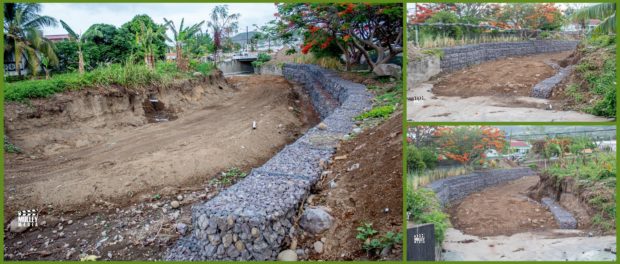Staunching the flow: St. Kitts and Nevis’ fight to keep its soil
Get our headlines on WHATSAPP: 1) Save +1 (869) 665-9125 to your contact list. 2) Send a WhatsApp message to that number so we can add you 3) Send your news, photos/videos to times.caribbean@gmail.com
 Installing gabion baskets to manage water flow and prevent further bank erosion is just one of the strategies IWEco is applying to rehabilitate the College Street Ghaut.
Installing gabion baskets to manage water flow and prevent further bank erosion is just one of the strategies IWEco is applying to rehabilitate the College Street Ghaut.
When you are a small island nation, every inch of space counts. But from rising sea levels to natural disasters and coastal erosion, in the age of climate change many islands are shrinking before their citizens’ very eyes.
Amongst those most at risk is the twin-island federation of St. Kitts and Nevis. Set in the Lesser Antilles, St Kitts and Nevis is threatened by both by sea level rise and the region’s increasingly frequent and severe hurricanes
But while the most visible threat to the island nation might be due to headline-making natural disasters, a less obvious enemy is slowly eating away at the islands from within – soil erosion.
The enemy within
St. Kitts and Nevis’ mountainous terrain is largely made up of sandy loam, cut through with ‘ghauts’ – narrow, deep gullies that deliver rainwater down the slopes. While the ghauts play a key role in maintaining the islands’ forest ecosystems, they are also ideal channels for eroding soil – and shifting land use, coupled with a lack of soil conservation measures, has resulted in acute erosion around the Federation.
A prime example is St. Kitts’ College Street Ghaut, which runs through the capital, Basseterre. Central to the 662-ha College Street Ghaut watershed, the ghaut funnels rainwater from the northern Mt Olivees down through Basseterre to the sea, but encroachment by agriculture and settlements, along with the destruction of protective vegetation, has resulted in increased erosion along its banks and across the upper reaches of the watershed.

Adding to the environmental toll caused by the loss of vital soil, flooding linked to land degradation and chronic sedimentation has become a frequent occurrence along the ghaut, with the last major flood in 2013 causing an estimated US$120,000 in damages.
“All one would hear is a rumble similar to large boulders coming down the road and then there is the rush of water moving and bringing down anything in its path,” local resident Leslie Connor says.
“There is damage to properties as the waters flow around unmovable obstacles and divert into yards and homes. You never know what it will do. It has been known to take cars and other items into the ocean and has even caused a loss of life.”
Fighting against the flow
Arresting the degradation that has opened the gates to increased flooding and erosion around the islands have become a top priority for the government of St Kitts and Nevis and their partners.
“The impacts of this land degradation are far-reaching and include public health risks due to flooding and inappropriate disposal of liquid and solid waste, as well as the loss of topsoil, poor water quality at the outlet of the ghaut and contamination of the nearshore environment,” Dr. Halla Sahely, national coordinator for the Integrating Water, Land and Ecosystems Management in the Caribbean Small Island Developing States (IWEco) project. “Works to reduce and control land degradation inside the ghaut are a critical first step towards a more proactive way of managing this important environmental zone.”
Led by the United Nations Environment Programme (UNEP) with the backing of the Global Environment Facility, IWEco is working to arrest the ghaut’s degradation. With diagnostic assessments of the ghaut completed in mid-2019, soil conservation measures are now underway. Gabion baskets (mesh cages filled with stone) are being used to manage water flow and fortify the channel, while deep-rooted vetiver grass is being planted along the ghaut’s banks to stabilize the soil and minimize erosion.

Alongside this restoration work, IWEco is working with local authorities and residents on a master planning framework for the watershed, helping to ensure the lessons learned from the conservation of the College Street Ghaut make their way into policy.
“For far too long, despite being granted special legal protected status, ghauts in St. Kitts and Nevis have had very limited active management in place,” Eavin Parry, an environmental scientist from the St Kitts and Nevis’ Ministry of Environment and Cooperatives says.
“The land degradation intervention being implemented under the IWEco project will demonstrate best practice to mitigate soil erosion and will catalyze greater active management of these types of natural drainage zones.”
The Integrating Water, Land and Ecosystems Management in Caribbean Small Island Developing States (IWEco) project is a five-year regional initiative contributing to the preservation of ecosystems of global significance through improved fresh and coastal water resources management, sustainable land management and sustainable forest management across 10 Caribbean nations (Antigua & Barbuda, Barbados, Cuba, Dominican Republic, Grenada, Jamaica, St. Kitts & Nevis, Saint Lucia, St. Vincent & the Grenadines, and Trinidad & Tobago).
For more information on IWEco contact jan.betlem@un.org. To learn more about UNEP’s work in International Waters, contact isabelle.vanderbeck@un.org.
Leave a comment
You must be logged in to post a comment.